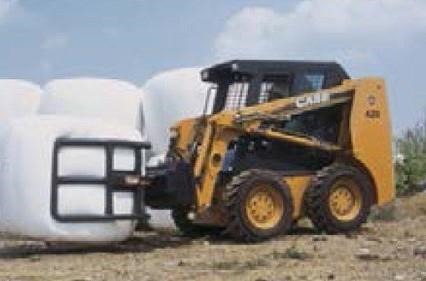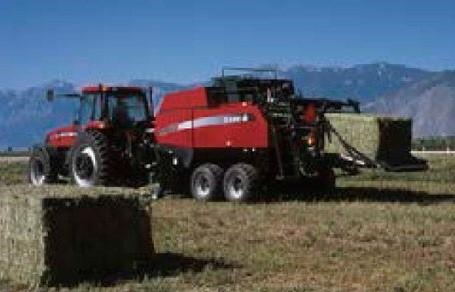Large hay bales may weigh 900 - 1700 pounds. Safe harvest practices must be followed through safe handling and storage procedures. This fact sheet addresses recommended practices to assure a safe harvest and use of large package hay balers.
Round Baler
A round baler involves multiple moving parts and the potential for an entanglement incident. At the beginning of each baling season, review the operations and safety precautions in the owner's manual, completely inspect the baler, and make any needed repairs. The owner's manual should provide the necessary guidelines to determine the correct size tractor to use with the baler to maintain proper control of the round baler. When choosing a tractor for baling, choose one that is equipped with a rollover protective structure (ROPS) and always securely buckle the seat belt.
Entanglement incidents present the greatest risk during baling activity. These types of incidents are avoidable if the operator remembers that entanglement occurs when the machine is running and the decision is made to leave the tractor seat without shutting down the tractor. Therefore, the operator should never leave the tractor seat until the power take-off (PTO) is disengaged, the tractor is shut down, the key is removed from the ignition and all moving parts have stopped turning.
Machine maintenance helps prevent entanglement opportunities as well. Keep all shields in place on the PTO driveline and all other moving parts. In order to reduce the risk of an injection injury, relieve the hydraulic pressure before disconnecting all hydraulic lines and use a piece of cardboard when examining the lines for leaks and malfunctioning parts. Use the hydraulic cylinder lock-out devices when working beneath raised baler components.
Safe Baling Reminders
Hay fields are not always flat so there are several important things to remember when baling on uneven or hilly terrain. Travel slowly on this type of terrain and avoid holes in the field and drop-offs. Round balers have a high center of gravity so it could potentially tip sideways if its wheel would go into a ditch or hole. During the baling process, avoid making sharp turns with the baler because the tractor wheels could hit the tongue of the baler and cause instability. When ejecting a bale on a hilly terrain, eject the bale so that it is perpendicular to the slope to reduce the risk of the round bale rolling down the slope. Due to the susceptibility of fires from baler belt friction and possible overheating of equipment, equip your tractor with a 10 pound (ABC) dry chemical fire extinguisher.
Bale Wrapping
Round bales can be wrapped individually or wrap into a row to preserve the feed quality of the hay. Individual bale wrapping is completed by a machine that lifts the bale from the field and applies plastic film around the bale as it is rolled and rotated on the machine's wrap table. A bale wrapper can be controlled manually, hydraulically or with a joy stick from the operator's seat. When the bale is completely wrapped, the plastic is cut and the bale is dropped from the wrap table.
Bale wrappers are designed to keep operators at a safe distance from the wrapping activities but there are still potential hazards that could cause an injury. Some wrappers are powered hydraulically. Pinch point and shear point hazards exist because of the moving parts in the lift arm and support table. To reduce the injury risk due to mechanical hazards, follow these recommendations:
- Make sure all shields are securely in place and replace worn or broken shields,
- Wear close-fitting clothing,
- Remove jewelry and drawstrings on hoods or jackets,
- Secure long hair,
- Turn off the machine and wait until all rotating parts have come to a complete stop before working on the machine, and
- Place or replace warning labels near hazards.

Bale Handling
Large round bales are usually moved with a front end loader. The best approach when using a front end loader is to remove the bucket from the loader and use an attachment designed to handle round bales, such as a grapple hook or bale spear. Check to make sure that both the tractor and the attachment are able to safely handle the weight and size of your round bales. The advantage of using a grapple hook or spear on your front-end loader is because it reduces the potential for the bale to roll back onto the loader arms or the operator. If moving bales with a front end loader, farmers should be aware of overhead power lines and remember the adage "Go slow and keep the load low."

The center of gravity on the tractor moves upward when it is carrying a bale. Farmers tend to raise the loader to increase their visibility which also raises the center of gravity and places the operator at an increased risk for a side overturn. Additional risk factors for side overturns are due to the loss of traction from driving on rough or wet terrain. Rear-mounted 3-point bale lifts solve the problem of not being able to see around large bales as you move forward but can introduce stability problems of their own. If using a rear-mounted 3-point lift to move round bales, do not lift the bale too high because the center of gravity will shift to the rear of the tractor which may raise the front of the tractor. If the front raises enough that the front tractor tires are barely touching the ground, the operator may have problems with steering and stability. Hauling bales simultaneously with a front-end loader and rear-mounted attachment can reduce the stability problem but it is important that you do not exceed the weight limit for the loader tractor's tire capacity. Remember to use counterweights on the front end or rear end to ensure good stability.
Large Square Bales
Large square bales are easier to stack and transport compared to large round bales. Use similar recommendations as already stated regarding bale handling to maintain the center of gravity of the tractor, skid steer loader, or telehandler. The weight of the bales may require the use of a larger tractor or the counterweights to maintain a proper balance.

Choose an appropriate sized, ROPS-equipped tractor when using a large square baler and always wear your seat belt. Avoid entanglement incidents by disengaging the PTO, shutting down the tractor's engine, and removing the key from the ignition before getting off of the tractor. All shields should be in place and replace any shields that are missing or damaged.
Hauling Round or Square Bales
Specialized bale wagons and trailers that carry multiple bales at a time have several advantages such as time savings, reduced risk for overturns, and reduced risk of overloading the tractor's hydraulic system. Choose an appropriate tractor that can handle and stop the wagon/trailer with the added weight of the bales and ensure that the wagon is properly hitched to the tractor's drawbar. This means using a safety pin and a safety chain. If transporting round bales on a public roadway, follow all traffic laws regarding wide loads and to properly secure the bales on the wagon/trailer with straps with a tensile strength of 1.5 times the load. The trailer or wagon should be highly visible with a SMV emblem, reflectors, and working warning lights. If using a pick-up truck to tow the load, check to make sure the truck has the necessary braking power to stop the load. If the load is wider than the tractor or truck and reduces visibility, consider using an escort vehicle to travel behind the load. Pull off the road at a safe spot to allow traffic to pass. Do not wave traffic around as this places the liability on the tractor or truck operator should an incident occur.
Source : psu.edu